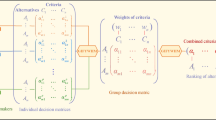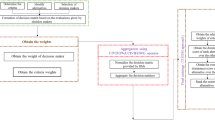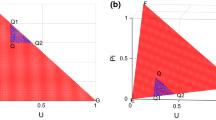Abstract
The present work proposes a novel integrated group decision making framework for decision making in IVIF setting employing Schweizer–Sklar t-conorm and t-norm (SSTT) aggregation operators, power average (PA) operators and TODIM (an acronym in Portuguese of interactive and multiple attribute decision making) methods. The SSTT aggregation operators make the aggregation process more flexible and the PA operators relive the decision making process from unreasonable data arising out due to biased evaluations. The TODIM method, on the other hand, ranks the alternatives by giving due consideration to the psychological behaviour of the expert towards risk. The extension of PA and SSTT operators to IVIF give rise to the weighted averaging and weighted geometric operators and are referred to as IVIFSSPAWA and IVIFSSPAWG operators. These operators, on integration with the TODIM method, give rise to two group decision making frameworks and are referred to as IVIFSSPWA fuzzy TODIM and IVIFSSPWG fuzzy TODIM approaches. The applicability of the proposed methods has been demonstrated through five illustrative examples from different domains: material selection, personnel selection, supplier selection, facility evaluation and technology evaluation. A comprehensive evaluation of the proposed methods with the considered illustrative examples aided to reveal the strength and weaknesses of the proposed approaches. The comprehensive analysis shows that the proposed IVIFSSPWA fuzzy TODIM and IVIFSSPWG fuzzy TODIM methods are superior to the benchmarks considered in the present work and also other MCDM methods without SSTT and PA aggregation operators and those ignoring the criticality of risk attitude of the experts. The proposed methodology, therefore, enhances the way of dealing with fuzzy information and in a way provides an improvisation of current studies.











Similar content being viewed by others
References
Abualigah LMQ (2019) Feature selection and enhanced krill herd algorithm for text document clustering. Springer, Berlin
Abualigah LM, Khader AT, Hanandeh ES (2019) Modified krill herd algorithm for global numerical optimization problems. In: Shandilya S, Shandilya S, Nagar A (eds) Advances in nature-inspired computing and applications. Springer, Cham, pp 205–221
Atanassov K, Gargov G (1989) Interval-valued intuitionistic fuzzy sets. Fuzzy Sets Syst 31(3):343–349
Beliakov G, Pradera A, Calvo T (2007) Aggregation functions: a guide for practitioners. Springer, Heidelberg
Bonferroni C (1950) Sulle medie multiple di potenze. Bollettino dell’Unione Matematica Italiana 5(3–4):267–270
Boran FE, Genc S, Kurt M, Akay D (2009) A multi-criteria intuitionistic fuzzy group decision makin for supplier selection with TOPSIS method. Exp Syst Appl 36(8):11363–11368
Chang Z, Cao J, Zhang Y (2018) A novel image segmentation approach for wood plate surface defect classification through convex optimization. J For Res 29(6):1789–1795
Davoudabadi R, Mousavi SM, Mohagheghi V (2019) A new last aggregation method of multi-attributes group decision making based on concepts of TODIM, WASPAS and TOPSIS under interval-valued intuitionistic fuzzy uncertainty. Knowl Inf Syst 60:1–21
Deng X, Gao H (2019) TODIM method for multiple attribute decision making with 2-tuple linguistic Pythagorean fuzzy information. J Intell Fuzzy Syst 37(2):1769–1780
Deng W, Zhao H, Zou L, Li G, Yang X, Wu D (2017a) A novel collaborative optimization algorithm in solving complex optimization problems. Soft Comput 21(15):4387–4398. https://doi.org/10.1007/s00500-016-2071-8
Deng W, Zhao H, Yang X, Xiong J, Sun M, Li B (2017b) Study on an improved adaptive PSO algorithm for solving multi-objective gate assignment. Appl Soft Comput 59:288–302. https://doi.org/10.1016/j.asoc.2017.06.004
Deng W, Xu J, Zhao H (2019) An improved ant colony optimization algorithm based on hybrid strategies for scheduling problem. IEEE Access 7:20281–20292. https://doi.org/10.1109/ACCESS.2019.2897580
Fan ZP, Zhang X, Chen FD, Liu Y (2013) Extended TODIM method for hybrid multiple attribute decision making problems. Knowl-Based Syst 1(42):40–48
Geng Y, Liu P, Teng F, Liu Z (2017) Pythagorean fuzzy uncertain linguistic TODIM method and their application to multiple criteria group decision making. J Intell Fuzzy Syst 33(6):3383–3395
Gomes LF (2009) An application of the TODIM method to the multicriteria rental evaluation of residential properties. Eur J Oper Res 193(1):204–211
Gomes LFAM, González XI (2012) Behavioral multi-criteria decision analysis: further elaborations on the TODIM method. Found Comput Decis Sci 37(1):3–8
Gomes LF, Lima MM (1992) TODIM: basics and application to multicriteria ranking of projects with environmental impacts. Found Comput Decis Sci 16(4):113–127
Hu J, Yang Y, Chen X (2018) A novel TODIM method-based three-way decision model for medical treatment selection. Int J Fuzzy Syst 20(4):1240–1255
Huang J, Li ZS, Liu HC (2017) New approach for failure mode and effect analysis using linguistic distribution assessments and TODIM method. Reliab Eng Syst Saf 167:302–309
Ji P, Zhang HY, Wang JQ (2017) Fuzzy decision-making framework for treatment selection based on the combined QUALIFLEX–TODIM method. Int J Syst Sci 48(14):3072–3086
Jiang Y, Liang X, Liang H (2017) An I-TODIM method for multi-attribute decision making with interval numbers. Soft Comput 21(18):5489–5506
Kahneman D, Tversky A (1979) Prospect theory: an analysis of decision under risk. Econometrica 47(2):363–391
Kazancoglu Y, Burmaoglu S (2013) ERP software selection with MCDM: application of TODIM method. Int J Bus Inf Syst 13(4):435–452
Krohling RA, Pacheco AGC (2014) Interval-valued intuitionistic fuzzy TODIM. Procedia Comput Sci 31:236–244
Lee YS, Shih HS (2016) Incremental analysis for generalized TODIM. CEJOR 24(4):901–922
Li M, Wu C, Zhang L, You LN (2015a) An intuitionistic fuzzy-TODIM method to solve distributor evaluation and selection problem. Int J Simul Model 14(3):511–524
Li Y, Shan Y, Liu P (2015) An extended TODIM method for group decision making with the interval intuitionistic fuzzy sets. Mathematical Problems in Engineering
Liu P (2013) Some Hamacher aggregation operators based on the interval-valued intuitionistic fuzzy numbers and their application to group decision making. IEEE Trans Fuzzy Syst 22(1):83–97
Liu P (2017) Multiple attribute group decision making method based on interval-valued intuitionistic fuzzy power Heronian aggregation operators. Comput Ind Eng 108:199–212
Liu P, Liu Y (2014) An approach to multiple attribute group decision making based on intuitionistic trapezoidal fuzzy power generalized aggregation operator. Int J Comput Intell Syst 7(2):291–304
Liu PD, Teng F (2016) An extended TODIM method for multiple attribute group decision-making based on 2-dimension uncertain linguistic variable. Complexity 21(5):20–30
Liu P, Teng F (2018) Multiple attribute decision making method based on normal neutrosophic generalized weighted power averaging operator. Int J Mach Learn Cybernet 9(2):281–293
Liu PD, Wang YM (2014) Multiple attribute group decision making methods based on intuitionistic linguistic power generalized aggregation operators. Appl Soft Comput 17:90–104
Liu P, Wang P (2018) Some interval-valued intuitionistic fuzzy Schweizer–Sklar power aggregation operators and their application to supplier selection. Int J Syst Sci 49(6):1188–1211
Liu PD, Li YH, Chen YB (2015) Some generalized Einstein aggregation operators based on the interval-valued intuitionistic fuzzy numbers and their application to group decision making. Sci Iran Trans E Ind Eng 22(6):2684
Liu J, Chi Y, Liu Z, He S (2019) Ensemble multi-objective evolutionary algorithm for gene regulatory network reconstruction based on fuzzy cognitive maps. CAAI Trans Intell Technol 4(1):24–36
Lourenzutti R, Krohling RA, Reformat MZ (2017) Choquet based TOPSIS and TODIM for dynamic and heterogeneous decision making with criteria interaction. Inf Sci 408:41–69
Lu J, Wei C (2019) TODIM method for performance appraisal on social-integration-based rural reconstruction with interval-valued intuitionistic fuzzy information. J Intell Fuzzy Syst 37(2):1731–1740
Mishra AR, Rani P (2018) Interval-valued intuitionistic fuzzy WASPAS method: application in reservoir flood control management policy. Group Decis Negot 27(6):1047–1078
Mishra AR, Rani P, Mardani A, Pardasani KR, Govindan K, Alrasheedi M (2020) Healthcare evaluation in hazardous waste recycling using novel interval-valued intuitionistic fuzzy information based on complex proportional assessment method. Comput Ind Eng 139:106140
Mohagheghi V, Mousavi SM, Aghamohagheghi M, Vahdani B (2017) A new approach of multi-criteria analysis for the evaluation and selection of sustainable transport investment projects under uncertainty: a case study. Int J Comput Intell Syst 10(1):605–626
Moshkovich HM, Gomes LFAM, Mechitov AI (2011) An integrated multicriteria decision-making approach to reale state evaluation: case of the TODIM method. Pesquisa Operacional 31(1):03–20
Nobre FF, Trotta LTF, Gomes LFAM (1999) Multi-criteria decision making–an approach to setting priorities in health care. Stat Med 18(23):3345–3354
Passos AC, Teixeira MG, Garcia KC, Cardoso AM, Gomes LFAM (2014) Using the TODIM-FSE method as a decision-making support methodology for oil spill response. Comput Oper Res 42:40–48
Qin J, Liu X, Pedrycz W (2017a) An extended TODIM multi-criteria group decision making method for green supplier selection in interval type-2 fuzzy environment. Eur J Oper Res 258(2):626–638
Qin Q, Liang F, Li L, Chen YW, Yu GF (2017b) A TODIM-based multi-criteria group decision making with triangular intuitionistic fuzzy numbers. Appl Soft Comput 55:93–107
Ren P, Xu Z, Gou X (2016) Pythagorean fuzzy TODIM approach to multi-criteria decision making. Appl Soft Comput 42:246–259
Ren Y, Chen J, Chen L, Zhang H, Zhang K (2018) Research and implementation of a universal workflow model to evaluate the soil fertility based on OGC Web Service. Geo-Spatial Inf Sci 21(4):346–357
Rodriguez RM, Martinez L, Herrera F (2011) Hesitant fuzzy linguistic term sets for decision making. IEEE Trans Fuzzy Syst 20(1):109–119
Sa LK, Nhung NC, Chien LV, Tuan NA, Tu PV (2018) Green material selection using an integrated fuzzy multi-criteria decision making model. Asian J Sci Res 11:195–202
Soni N, Christian RA, Jariwala N (2016) Pollution potential ranking of industries using classical TODIM method. J Environ Prot 7(11):1645–1656
Tan C, Jiang ZZ, Chen X (2015) An extended TODIM method for hesitant fuzzy interactive multicriteria decision making based on generalized Choquet integral. J Intell Fuzzy Syst 29(1):293–305
Tosun Ö, Akyüz G (2015) A fuzzy TODIM approach for the supplier selection problem. Int J Comput Intell Syst 8(2):317–329
Tversky A, Kahneman D (1992) Advances in prospect theory: cumulative representation of uncertainty. J Risk uncertain 5(4):297–323
Wang SW, Liu J (2017) Extension of the TODIM method to intuitionistic linguistic multiple attribute decision making. Symmetry 9(6):95
Wang L, Wang YM, Martínez L (2017) A group decision method based on prospect theory for emergency situations. Inf Sci 418:119–135
Wang J, Wei G, Lu M (2018a) TODIM method for multiple attribute group decision making under 2-tuple linguistic neutrosophic environment. Symmetry 10(10):486
Wang J, Wei G, Lu M (2018b) An extended VIKOR method for multiple criteria group decision making with triangular fuzzy neutrosophic numbers. Symmetry 10(10):497
Wang P, Wang J, Wei G, Wei C (2019) Similarity measures of q-rung orthopair fuzzy sets based on cosine function and their applications. Mathematics 7(4):340
Wei G, Wei C, Wang J, Gao H, Wei Y (2019) Some q-rung orthopair fuzzy maclaurin symmetric mean operators and their applications to potential evaluation of emerging technology commercialization. Int J Intell Syst 34(1):50–81
Wu J, Chiclana F (2014) A risk attitudinal ranking method for interval-valued intuitionistic fuzzy numbers based on novel attitudinal expected score and accuracy functions. Appl Soft Comput 22:272–286
Xu ZS (2007a) Intuitionistic fuzzy aggregation operators. IEEE Trans Fuzzy Syst 15(6):1179–1187
Xu ZS (2007b) Methods for aggregating interval-valued intuitionistic fuzzy information and their application to decision making. Control Dec 22(2):215–219
Xu Z, Yager RR (2009) Intuitionistic and interval-valued intutionistic fuzzy preference relations and their measures of similarity for the evaluation of agreement within a group. Fuzzy Optim Decis Mak 8(2):123–139
Yager RR (1988) On ordered weighted averaging aggregation operators in multicriteria decision making. IEEE Trans Syst Man Cybern 18(1):183–190
Yager RR (2001) The power average operator. IEEE Trans Syst Man Cybern-Part A: Syst Hum 31(6):724–731
Yu W, Zhang Z, Zhong Q, Sun L (2017) Extended TODIM for multi-criteria group decision making based on unbalanced hesitant fuzzy linguistic term sets. Comput Ind Eng 114:316–328
Yue C (2019) An interval-valued intuitionistic fuzzy projection-based approach and application to evaluating knowledge transfer effectiveness. Neural Comput Appl 31(11):7685–7706
Zadeh LA (1965) Fuzzy sets. Inf Control 8:338–353
Zhang Q, Xing H, Liu F, Ye J, Tang P (2014) Some new entropy measures for interval-valued intuitionistic fuzzy sets based on distances and their relationships with similarity and inclusion measures. Inf Sci 283:55–69
Zhang X, Liu P, Wang Y (2015) Multiple attribute group decision making methods based on intuitionistic fuzzy frank power aggregation operators. J Intell Fuzzy Syst 29(5):2235–2246
Zhao H, Liu H, Xu J, Deng W (2019) Performance prediction using high-order differential mathematical morphology gradient spectrum entropy and extreme learning machine. IEEE Trans Instrum Meas. https://doi.org/10.1109/TIM.2019.2948414
Zindani D, Maity SR, Bhowmik S, Chakraborty S (2017) A material selection approach using the TODIM (TOmada de Decisao Interativa Multicriterio) method and its analysis. Int J Mater Res 108(5):345–354
Zindani D, Maity SR, Bhowmik S (2018) A decision-making approach for material selection of polymeric composite bumper beam. In: Kumar K, Davim JP (eds) Composites and advanced materials for industrial applications. IGI Global, Hershey, pp 112–128
Funding
No funding was received to perform the present work.
Author information
Authors and Affiliations
Corresponding author
Ethics declarations
Conflict of interest
All the authors of the present work have no conflict of interest.
Ethical approval
This article does not contain any studies with human participants or animals performed by any of the authors.
Additional information
Communicated by V. Loia.
Publisher's Note
Springer Nature remains neutral with regard to jurisdictional claims in published maps and institutional affiliations.
Rights and permissions
About this article
Cite this article
Zindani, D., Maity, S.R. & Bhowmik, S. Interval-valued intuitionistic fuzzy TODIM method based on Schweizer–Sklar power aggregation operators and their applications to group decision making. Soft Comput 24, 14091–14133 (2020). https://doi.org/10.1007/s00500-020-04783-1
Published:
Issue Date:
DOI: https://doi.org/10.1007/s00500-020-04783-1




